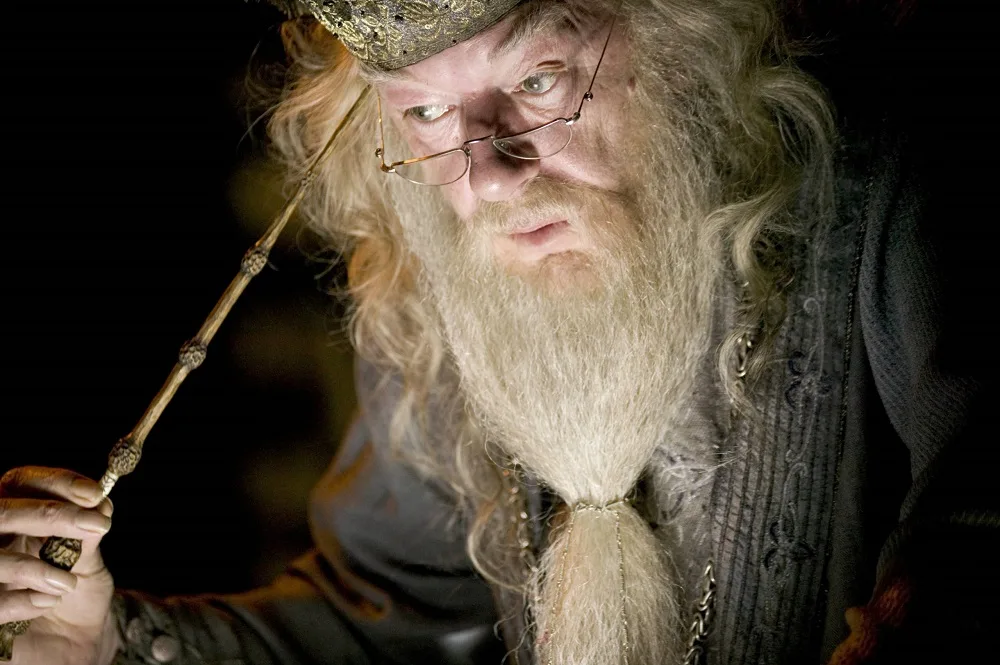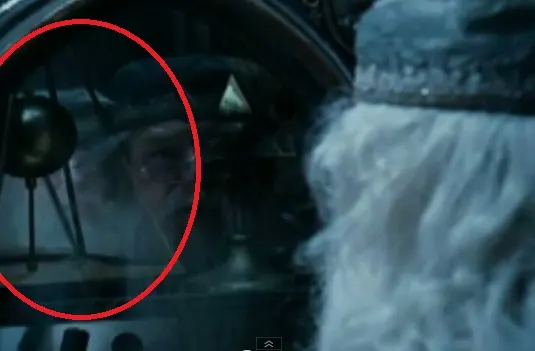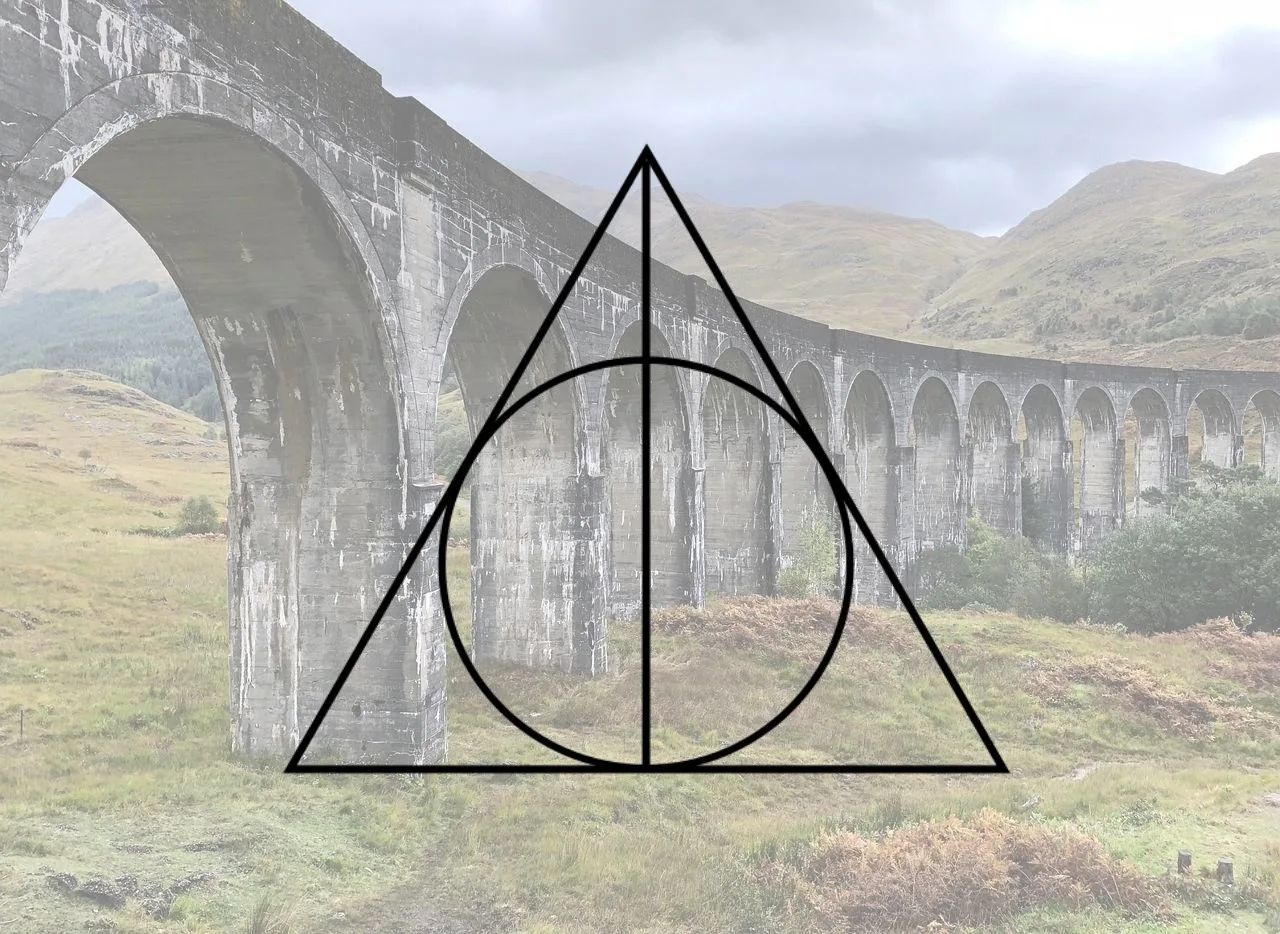“Deathly Hallows,” a significant term in the Harry Potter series, refers to three of the most powerful magical objects in the wizarding world: the Elder Wand, the Resurrection Stone, and the Invisibility Cloak. These objects are symbolized by a unique sign, recognized widely by Harry Potter fans as the Deathly Hallows symbol.
This article will delve into the intricate details and interpretations of the triangle, the circle and the straight vertical line, exploring its role and impact on the world of Harry Potter.
Deathly Hallows Symbol Meaning
The Deathly Hallows symbol is an elegant and simple design that unites three distinct elements, each representing one of the Hallows.
The Deathly Hallows symbol consists of a triangle which represents the Invisibility Cloak, a straight vertical line inside the triangle symbolizing the Elder Wand, and a smaller circle inside the triangle, denoting the Resurrection Stone.
1. The Triangle Meaning (Cloak of Invisibility Hallow)

The triangle in the Deathly Hallows symbol represents the Cloak of Invisibility, one of the three Deathly Hallows in the Harry Potter series. It symbolizes protection, evasion, and the acceptance of mortality, as the cloak allows its user to avoid death, not by cheating it but by avoiding confrontation.
The triangle, as part of the whole symbol, demonstrates the balance between the three Hallows, and their collective power when united. This cloak, specifically, is passed down to Harry Potter and plays a significant role throughout the series.
The Triangle’s Significance to Characters and Plot
The cloak is more than just an item of protection – it’s a symbol of Harry’s heritage, passed down from his ancestor Ignotus Peverell, one of the original owners of the Hallows. The invisibility cloak is a link to Harry’s past and a symbol of his connection to his parents, who left it to him. It’s also a critical tool that enables Harry and his friends to undertake many of their most important missions without being detected by their enemies.
Throughout the series, the cloak of invisibility becomes a lifeline for Harry and his friends. It helps them escape capture, discover secrets, and perform many tasks unnoticed. It is used extensively in the series, from rescuing Sirius Black from the tower in “The Prisoner of Azkaban” to infiltrating the Ministry of Magic in “The Deathly Hallows.”
Moreover, the cloak symbolizes the idea of a prudent use of power. Unlike the other two Hallows that are used to dominate (the Elder Wand) or disrupt the natural order (the Resurrection Stone), the cloak is a tool of protection, safety, and discretion. It teaches the value of using power wisely and subtly, rather than seeking to dominate or control others. This is a lesson that Harry learns and embodies throughout the series.
2. The Circle Meaning (Resurrection Stone Hallow)

The circle in the Deathly Hallows symbol signifies the Resurrection Stone, one of the three Deathly Hallows in the Harry Potter series. Its an item steeped in sorrow and caution. The Stone is said to possess the power to bring the departed back from the dead, albeit only as ethereal and melancholic echoes of their past selves.
Its existence serves as a haunting reminder of the dangerous allure of disrupting life’s natural order, and the price one pays for not accepting the inevitability of death.
The Circle’s Significance to Characters and Plot
The Resurrection Stone, as represented by the circle in the Deathly Hallows symbol, holds profound significance to the characters, particularly Harry Potter, and influences the plot notably towards the climax of the series.
When Harry unknowingly comes into possession of the Stone, it becomes a tool of solace and courage during his selfless act of sacrifice in the Forbidden Forest. It is with the Resurrection Stone that Harry resurrects spectral forms of his loved ones – Lily and James Potter, Sirius Black, and Remus Lupin – who provide him with comfort and the courage to face his seeming demise. In this poignant moment, the circle’s meaning of resurrection transforms into a symbol of emotional strength and the unbreakable bonds of love.
The Resurrection Stone also deepens the complexity of Albus Dumbledore’s character. It reveals his longing to undo his past mistakes, which leads him to a grave error of using the cursed ring that houses the Stone. This mistake, while demonstrating his fallibility, also shows his human struggle with guilt and regret.
Read more: Does Dumbledore Come Back to Life?
3. The Vertical Line Meaning (Elder Wand Hallow)

The vertical line in the Deathly Hallows symbol represents the Elder Wand, one of the three Hallows in the Harry Potter series. The Elder Wand is known as the most powerful wand in existence, capable of feats of magic unparalleled by any other wand.
The Elder Wand represents the raw power of magic, but it also stands as a warning that power in the wrong hands, or used without wisdom, can lead to destruction and downfall. This dual meaning adds a layer of depth to the narrative, emphasizing the moral complexities of power and ambition within the wizarding world.
The Vertical Line’s Significance to Characters and Plot
The Elder Wand, symbolized by the vertical line in the Deathly Hallows, has profound significance to several characters and the overall plot of the Harry Potter series. For Albus Dumbledore, it was a tool to protect and guide Hogwarts students, although he also recognized its inherent dangers. His ability to wield the wand without being corrupted demonstrated his exceptional wisdom and selflessness.
In contrast, Lord Voldemort’s pursuit of the Elder Wand, which he believed would make him invincible, demonstrated his obsession with power and immortality. His failure to fully master the wand, however, highlighted his fundamental misunderstanding of the nature of power, specifically the power of self-sacrifice and love.
The Elder Wand’s journey, from Dumbledore to Draco Malfoy to Harry Potter, exemplified the unexpected ways that power can shift and highlighted the importance of one’s intentions and actions. Harry’s final decision to return the wand to Dumbledore’s tomb signaled his rejection of power for its own sake, reaffirming the series’ theme that love, humility, and sacrifice hold the true power.
Deathly Hallows Symbol Origin

The Deathly Hallows symbol has a rich origin within the narrative of the Harry Potter series. It was first introduced to readers in “Harry Potter and the Deathly Hallows,” the final book of the series.
The symbol’s design comes from the story of the Deathly Hallows, as told by Xenophilius Lovegood to Harry, Hermione, and Ron. According to the tale, which is part of “The Tales of Beedle the Bard,” a collection of stories known to all wizard children, the Hallows were given by Death himself to the three Peverell brothers. Each brother received a different Hallow based on their deepest desire.
The symbol became associated with Grindelwald, who used it as his mark. It was often misinterpreted as representing his ambition to unite the three Hallows and become the master of death, a misinterpretation that led many to fear the symbol.
In the wizarding world, the symbol is controversial. Some, like Xenophilius Lovegood, believe in the Deathly Hallows and consider the symbol a mark of enlightenment and wisdom. Others, like Hermione Granger, initially see it as nothing more than a dangerous obsession or a myth.
Over time, the symbol comes to represent Harry’s journey of understanding and accepting his role and fate in the wizarding world, making the Deathly Hallows symbol an integral part of the series’ mythology.
The origins of the Deathly Hallows sprung from Beedle the Bard’s fairy tale “The Tale of the Three Brothers”. The three brothers are the Peverell’s – Antioch, Cadmus, and Ignotus.
“Who are the Peverells?” asked Ron.
“That was the name on the grave with the mark on it, in Godric’s Hollow,” said Hermione, still watching Xenophilius. “Ignotus Peverell.”
“Exactly!” said Xenophilius, his forefinger raised pedantically. “The sign of the Death Hallows on Ignotus’s grave is conclusive proof!”
Harry Potter and the Deathly Hallows
Though notoriously unreliable to separate facts from fiction, his knowledge of the Hallows turns out to be precisely what the three need. He shares his belief that the Hallows are the focal point of The Tale of the Three Brothers and asks Hermoine to read it to them.
The Story of the Deathly Hallows
The story goes that these three men were wandering a dark path alongside each other when they came across a dangerous river. All three men are wizards, so they cast a spell to erect a bridge across the river for safe passage.
As they attempt to pass, a cloaked dark figure appears, blocking their path. It turns out to be Death. Death is upset that these three evaded dying in the treacherous waters as wanderers usually did. Cunningly, Death offers each of the men a gift for being clever enough to trick Death. This is how the Deathly Hallows came into existence- at least according to this children’s tale.
The eldest brother, Antioch, asks for the most powerful wand in existence. Death creates the Elder Wand from a nearby Elder tree. The second brother, Cadmus, asks for the power to bring people back to life. Death creates the resurrection stone from a pebble he picks off the riverbank. The youngest brother, Ignotus, doesn’t trust Death and asks for the means to walk away without Death following him. Death reluctantly cuts off a piece of his own cloak- thus, creating the cloak of invisibility.
The story goes on to follow each of the brothers to their death, with the youngest brother, Ignotus, passing on the invisibility cloak to his son. We later learn that Harry is a distant relative of Ignotus, whose cloak passed down to him through the generations. (Source)

